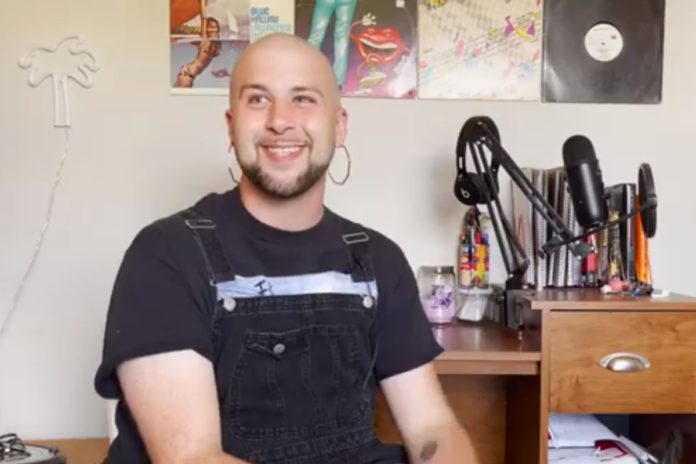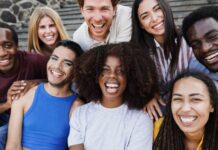CLARKSVILLE, TN (CLARKSVILLE NOW) – Jeremy Sumner said it was a struggle growing up, as he was isolated from his family after coming out as gay.
“By the time I was 15, it was a situation that was untenable for my mother,” said Sumner, now 44. “I was sent away to boarding school to be away from my younger brother and sister because she was afraid that I was going to molest them … she got rid of the family dog because she thought I was going to molest that, too.”
That was 30 years ago, and much has changed, even in the last five years, but many LGBTQ+ people continue to face alienation or outright hostility.
During Pride Month in June, Clarksville Now spoke to several people in the local LGBTQ+ community. While the interviews don’t encompass the entirety of the community and the diversity within it, this is what they had to say on what it means to be proud.
Bumpy road to self-discovery
Kyle Pearce, 28, identifies as non-binary, meaning a person who doesn’t conform to either male or female, and pansexual, meaning a person who is attracted to those of all genders. Pearce says that they lived in denial and confusion for most of their younger life.

“I didn’t even know what (gay) was until church,” Pearce said. “At first I was excited because I was like ‘That sounds like me,’ and then I heard ‘abomination,’ and ‘it’s evil’ and ‘you’re going to hell.’”
Living with a lot of guilt upon this discovery, Pearce said they struggled to achieve self-acceptance. “I’m going to die one day, and do I really want to die living half a life?”
Pearce went back and forth from identifying as gay before finally coming to the decision that they were pansexual.
“Your physical (body) is such a temporary thing – why would I consider such a temporary factor in a potentially long-term decision?”
Pearce told Clarksville Now that it’s not just about them. “I represent people that are like me.”

Jade Irwin, 19, identifies as a pansexual woman.
“I didn’t have a lot of exposure to people in the LGBT+ community,” Irwin said. “I grew up relatively sheltered.”
Irwin came out to her family and friends when she was 14 as bisexual, meaning attracted to men and women. It was only a few months ago that she started re-thinking this.
“I felt that bisexuality didn’t really define how I felt and how I loved people,” she said. “It was like wearing a pair of pants that doesn’t really fit. Like, it’s your size, but the waist is kind of too big or the legs are too short, so it fits, but you kind of avoid wearing them.”
Irwin decided pansexuality fit her best. “People are so easy to fall in love with.”
Irwin said she has generally had a supportive system, but a lot of people have assumed that she was just wanting attention.
“Just because you don’t understand something, it’s not inherently bad,” said Irwin. “You don’t have to understand everything. The only person it needs to make sense to is that individual,” she said.

Mason Thornhill, 24, is a transgender male, and he came out three years ago.
“Before I came out as trans, I came out as a lesbian,” Thornhill said. “I fought with that for a very long time.”
Although his family has generally been supportive through this process, he has had a tough time with others.
“Some days are better than others,” said Thornhill, “some people are definitely a lot more kind with it; they try, they correct themselves.”
However, Thornhill still has a problem with people misgendering him. “They will use she/her pronouns on a daily basis.”

Jeremy Sumner, 44, identifies as a gay man. “I think the closet burned down around me; I kind of knew from a very early age,” he said.
Sumner told Clarksville Now that he grew up in theatre, which was a significant influence on him. “It put me around a lot of older women and older men who were like, ‘Oh, that boy’s a fruit.’ And it was accepted, so I really got comfortable in my own skin.”
Despite being around such a welcoming environment, things were very different at home.
Sumner said his mother not only actively tried to change him, but she feared him and isolated him. “She felt like it was a reflection on her of poor parenting.
“When I was at boarding school, I never really pretended to be anything other than what I was; It was sort of like ‘I’m here, I’m queer, get used to it.’ People either loved me for that, or they absolutely hated me for it.”
Sumner said loving himself is an ongoing process. “I had never felt any self-acceptance because I was seeking everybody else’s.”
Growing up in the ’70s and ’80s, Sumner witnessed gay liberation movements and the HIV/AIDS epidemic.
“That level of fear – I think we got the briefest hint of in the COVID experience. I think for straight people, COVID was their first brush with (a disease) they couldn’t control,” said Sumner.
During the height of the AIDS crisis, he said, “You saw people that suddenly weren’t there anymore; when you went to the clubs, the person you were dancing with last weekend might not be there again.”
 100vw, 1200px”>
</p>
<p><strong>Torrence Fritz, </strong>25, is a trans masculine-presenting person. Torrence is also the founder of <a rel=)
“A big (assumption) I’ve gotten is that my sexuality stems from abuse when I was younger, which that isn’t true at all,” Fritz said.
Fritz has taken testosterone throughout his transition and said it isn’t an overnight process.
“You go through that awkward puberty stage where you’re a little depressed,” Fritz said. “Some trans people have dysphoria, and that just makes it worse.”

Dani J, 30, is a trans queer man and has identified as such since 2015 when he came out to his mother.
He came out publicly last year and began transitioning his appearance.
“Here I am at 30 years old, finding myself all over again,” Dani said.
“The hardest part of the transitioning process might be dealing with a whole new list of changes coming your way, not just in a physical sense but in an emotional sense as well,” Dani said.
On being Black and trans
This year, the Pride flag has a black and brown stripe to represent people of color and their contribution to the LGBTQIA+ community.
“The whole reason we have a Pride flag, and Pride to begin with, is because of people like Marsha P. Johnson who was a Black, trans woman who started the Stonewall riots because they wouldn’t allow her into a bar,” Pearce said. “I think America, in general, is built on the backs of people of color without any reconciliation.”
The Stonewall riots were a series of demonstrations in 1969 that went on from June 28 to July 3, sparked by police raids at gay bars in New York.
“With all of the legislation going against us as non-straight people, that has been life for hundreds of years for all people of color in this country,” said Irwin.
“We all watched on television as George Floyd was strangled in front of us,” Sumner said. “When you marginalize any one person or any group of people, we are all diminished a little bit.”
Dani told Clarksville Now he’s been able to experience two worlds, previously as a Black woman and now a Black man in America.
“Black females – people think they’re loud, aggressive, intimidating, etc. They can be perceived as their own type of threat to some people, but not so much of a threat as the Black man poses.”
Dani said being a black man comes with its own set of microaggressions.
“People will approach me with a little more caution,” Dani said. “I have to think about now how do I appear the least threatening?”
After coming out
For those still struggling, this group of individuals said it won’t always be like that. Coming to realizations about how you choose to identify, as well as the self-acceptance that follows, is an uphill battle.
“Somehow I thought in my head that sometime in the future, life is going to be easier for (the LGBTQ+ community), and then I can be happy, and I finally realized that life was never going to let up like that,” Sumner said. “You have to make the conscious choice to be happy.”
“You’ll understand yourself a lot more, and not care if other people do,” Pearce said. “You should be proud because people tell you to not be.”
Thornhill suggests learning more about the terminology, and not just sticking to the first thing that fits. “Do your research,” he said, “look more into it, because it took me a year to figure out.”
Dani said he wishes he would’ve known the support system he had waiting for him before he came out.
“You are taking a step out on faith, you’re walking into something that is not for certain, but it’s important to take that first step,” he said.
Sumner said he wants people to see the human side of one another, rather than making assumptions based on sexuality.
“I think if more people saw that, versus focusing on what divides us, we’d be a lot better off.”
MORE: Gay history in Clarksville: 6 pivotal moments for local LGBTQ community








